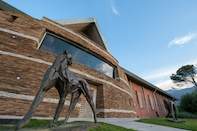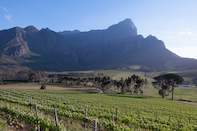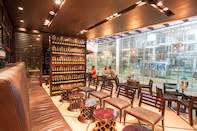At Terra del Capo is sophisticated wine farming, from scientific land cultivation to hi-tech cellar operations. But there’s room for beauty too, as the informed staff share their appreciation of fine wine, culinary delicacies and cutting-edge technology.
Consolidating Cellars

The Franschhoek cellar and tasting room of Terra del Capo, comprising two of four winemaking facilities belonging to Antonij Rupert Wyne (based next door on what was historic French Huguenot wine farm L’Ormarins), is probably one of the finest examples of contemporary aesthetics in the Cape winelands. To visit this winery is to explore wine as an art form - and to everyone here, that is precisely what wine is.
It was formerly part of historic Bellingham wine estate, the birthplace of such famous mid-20th-century Cape wine styles as the Premier Grand Cru dry white blend and South Africa’s finest single-varietal Shiraz by Cape wine pioneer Bernard Podlashuk.
In 1990, the farm and its vineyards (excluding the old Cape Dutch Bellingham Homestead now run as an accommodation establishment by the Podlashuk Bellinchamp National Heritage Foundation) were acquired by Robertson’s Graham Beck.
In 2011, shortly after Beck’s passing, the more than 400 hectares of land plus two cellars (dedicated to white wine- and red winemaking respectively) were sold to a neighbour: South African international business titan Johann Rupert.
The two properties have combined their vineyards (and purchase grapes elsewhere). They are however run as two individual wineries, with their own white-wine and red-wine cellars and tasting rooms, but sharing a quartet of winemakers with their own individual areas of expertise.
The home base of Anthonij Rupert Wyne is on what was the original French Huguenot farm L’Ormarins, developed, restored and established as a premium wine brand by Rupert’s younger brother Anthonij. When the elder Rupert took over the property upon his brother’s untimely death in 2001, he re-named it in memoriam.
Contemporary and Cutting Edge

Beck’s original transformation of what is now the Terra del Capo site included the replanting of some 70 hectares of primarily classic red varieties on the steep granite and sandstone slopes of Groot Drakenstein and a revamp of the existing cellar to specialise in white wines. It also involved the construction of a state-of-the-art red wine cellar, breaking new ground in aesthetic design.
Johan Wessels, the architect of Beck’s eponymous avant-garde Robertson winery, was briefed to combine the traditional with the modern on the Franschhoek property.
The result, which is sandblasted red-brick walls and multi-hued tiles, is reminiscent of Burgundy and Tuscany but brought right up to date with the concrete trim, grey slate drywalls and expansive plate-glass windows, overlooking rolling parkland with the imposing Groot Drakenstein peak behind.
The tasting room, guarded by a pair of Dylan Lewis bronze cheetahs and created by Cape Town interior designer John Zwiegelaar, is both sophisticated and convivial. Recessed spotlighting plays on floor-to-ceiling varnished black and wine-red wood, gleaming granite floors and custom-made bronze fittings.
Casual tastings are at incidental tables, with a mezzanine level for formal guided tastings. Particularly noteworthy is the muted ‘live entertainment: a hi-tech bottling line behind a plate-glass window - in a single hour you could witness some 3 000 bottles being filled with wine.
Sipping and snacking at Terra del Capo is carefully curated, with a nod to Italian countryside wining and dining.
The winery offers a range of Terra del Capo Experiences, which need to be pre-booked but cater for all tastes and means in different flights from specific ranges within the greater Anthonij Rupert Wyne portfolio: The classic reds in the Protea range; the Terra del Capo Italian varieties Pinot Grigio, Sangiovese and co-fermented Sangiovese and Merlot; ‘zesty’ Sauvignon Blancs from the Protea and Cape of Good Hope ranges; and the Cap Classique sparkling wines under the L’Ormarins label.
A Taste of Italy

The Italian theme continues with the eating options, offered at bistro-style tables in the tasting room or outdoors at wooden tables in copses of olive trees. The Antipasti Bar offers a selection of small dishes with suggested wines as accompaniment.
A truffle inspired lunch offers three courses matched with wines highlighting Périgord (black) truffles cultivated on the farm. The estate olive oil tasting features estate olive oil with breads and artisanal cheeses paired with selected wines. There is also an Italian cheese and wine experience
Wines displayed from floor to ceiling are part of the tasting room décor, with shelves in the adjoining deli filled with produce from the farm and other Cape delicacies: home-baked breads, olive oils, honey, charcuterie from the farm’s Black Angus herd, truffles, artisanal pasta, pickles and preserves and farm cheeses.
Although a destination on its own, the Terra del Capo winery is linked by an estate tram to sister cellar, the restored historic Cape Dutch L’Ormarins homestead with its own ultra-modern production facilities (including a novel, circular, gravity-fed red wine cellar). Here too a range of similar (but different) pre-booked wine tasting and eating ‘experiences’ are offered.
Another stop on the route (by prior arrangement) is the Franschhoek Motor Museum, showcasing Rupert’s extensive collection of restored vintage vehicles (one or two of which take to the estate’s roads for a pre-arranged vineyard drive for the true enthusiast).
 This mountain-ringed valley’s celebrated French character comes from the Huguenots, refugee French Protestants who settled here during the...
This mountain-ringed valley’s celebrated French character comes from the Huguenots, refugee French Protestants who settled here during the...